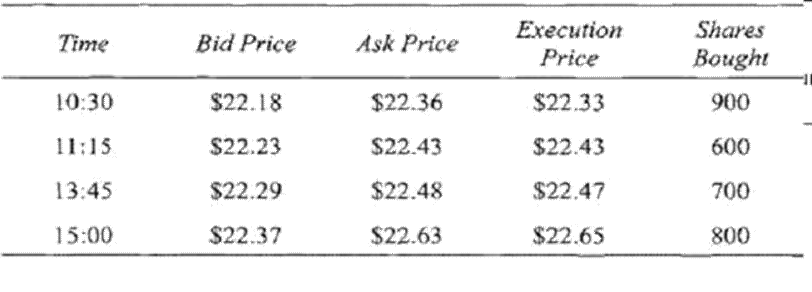Somerset Investment Limited is a Singapore-based money management firm that is conducting an appraisal of its investment performance. Cameron Li, CFA, has been charged with conducting the appraisal, and is to report back to upper management with his findings.
Somerset Investment Limited is a Singapore-based money management firm that is conducting an appraisal of its investment performance. Cameron Li, CFA, has been charged with conducting the appraisal, and is to report back to upper management with his findings.
Li is convinced that trade executions play a substantial role in overall portfolio performance, particularly for funds that have a relatively high level of turnover during the year. As a result, he is seeking methods that will allow him to evaluate the quality of trade executions.
He knows that the firm’s traders use both market and limit orders, and he is wondering if a framework can be developed to ensure that the best order type is used under the specific circumstances for each trade. When he consults with the firm’s head trader, Rick Gleeson, Gleeson tells him that market orders have price uncertainty but no execution uncertainty, while limit orders eliminate price uncertainty but have execution uncertainty. According to Gleeson, rebalancing and liquidity-motivated trades should use limit orders while value-motivated and information-motivated trades should use market orders.
Li knows that bid-ask spreads are a major component of trading costs, and asks Gleeson for some recent trade data that he can use for analysis and presentation to management. He receives the following data relating to a series of buy trades for Sumatra Natural Resources (SNR), with all currency values in Singapore dollars:
Trades of Sumatra Natural Resources

Gleeson also tells Li that the portfolio manager had originally made the decision to purchase 5,000 SNR at 10:00 a.m. when the price was $22.36. The closing price for the day was Leeson’s last trade at $22.65, at which point the order for the remaining 2,000 shares was cancelled.
Calculate the implementation shortfall assuming total commissions paid by Glceson when he purchased the 3,000 SNR were $210.
A . 0.303%.
B . 0.996%.
C . 2.027%.
Answer: B
Explanation:
The benchmark price is 22.36, and the benchmark quantity is 5,000, so the benchmark investment = 22.36 x 5,000 = $111,800. The terminal benchmark value = 22.65 x 5,000 – $113,250, and the benchmark gain = 113,250 – 111,800 = $1,450.
The actual portfolio cost = (900 x 22.33) + (600 x 22.43) +(700 x 22.47) + (800 x 22.65) = 67,404 + 210 = $67,614. The actual portfolio terminal value = 22.65 x 3,000 = $67,950, and the actual gain = 67,950 – 67,614 = $336.
The implementation shortfall = (1,400 – 336) / 111,800 = 0.0096 or 0.996%. (Study Session 16, LOS 45.g)
Latest CFA Level 3 Dumps Valid Version with 362 Q&As
Latest And Valid Q&A | Instant Download | Once Fail, Full Refund

